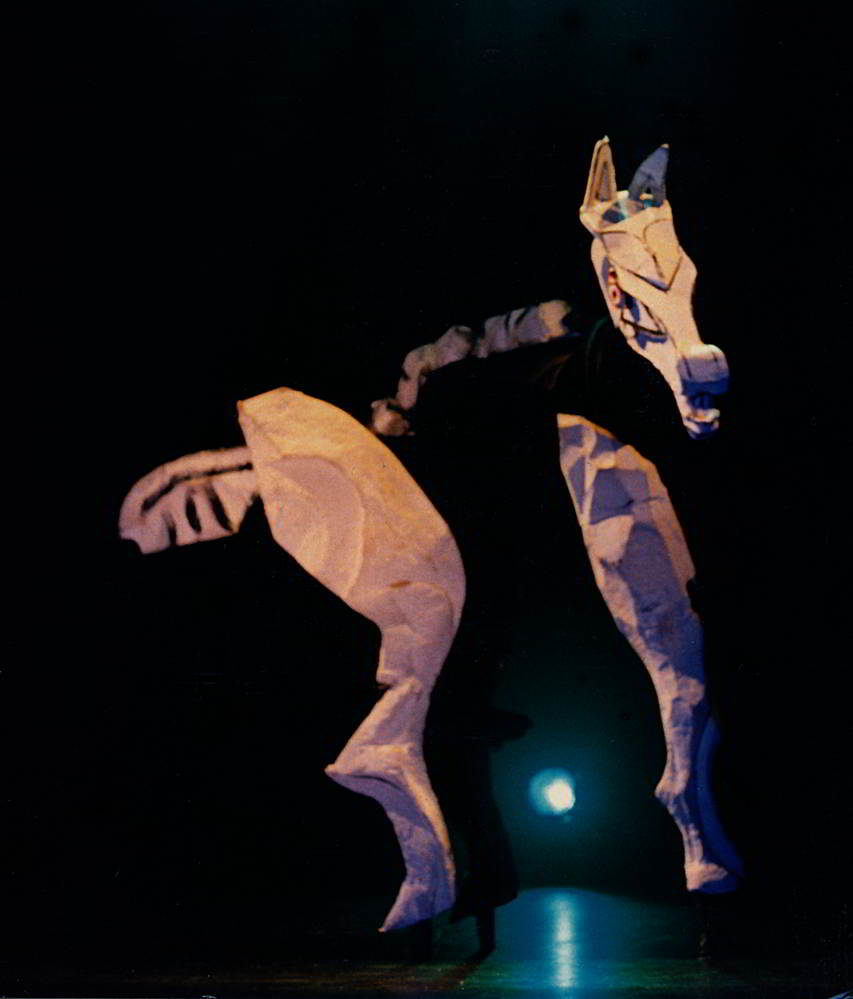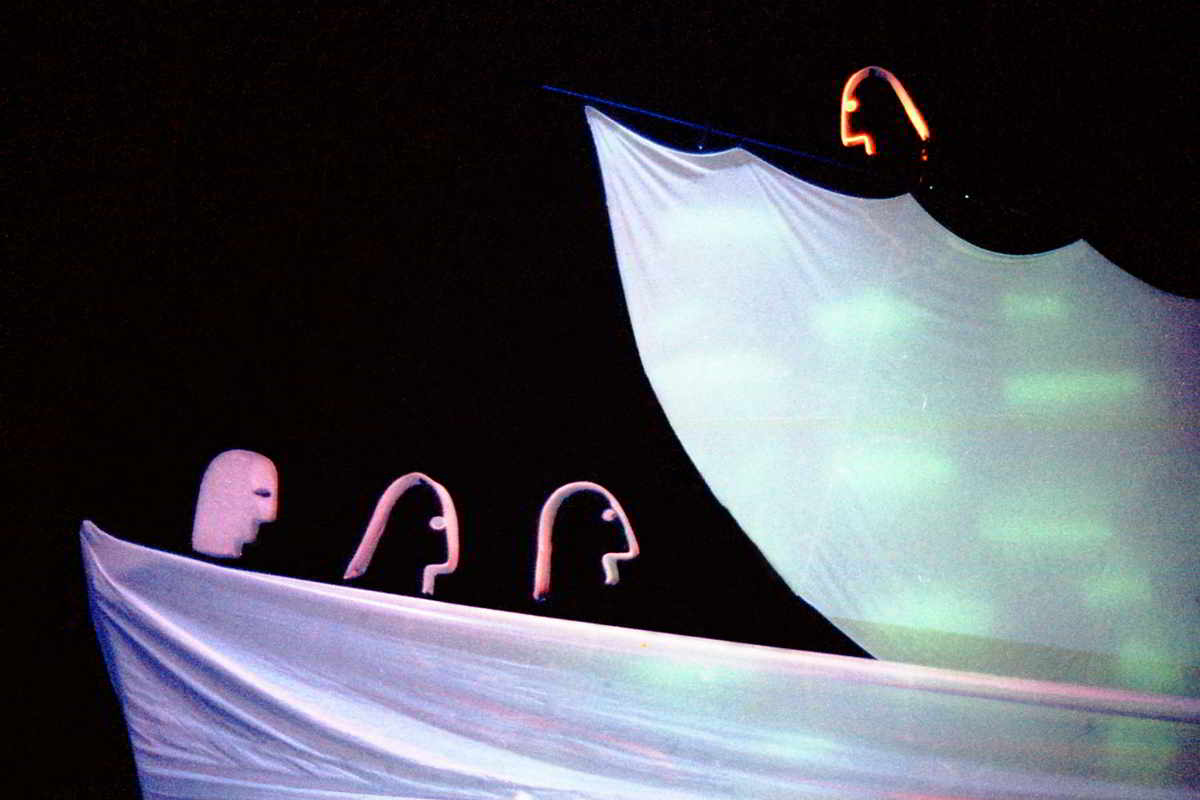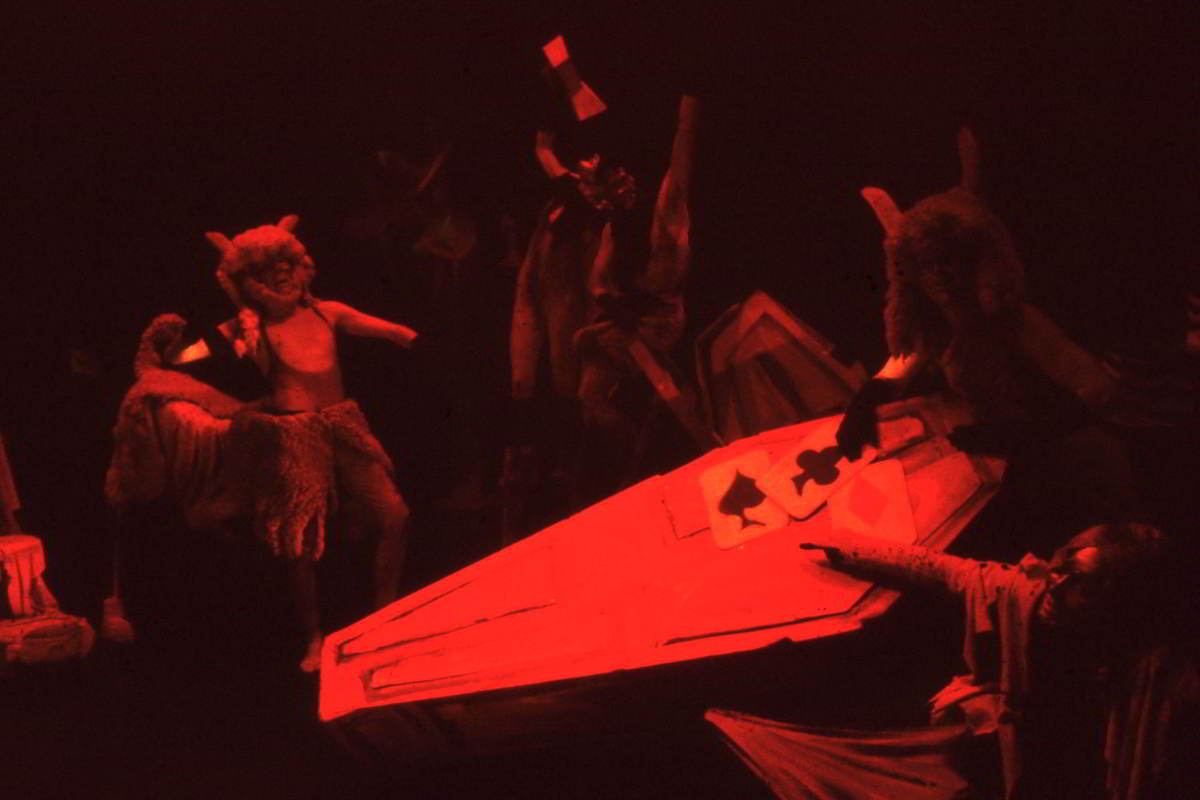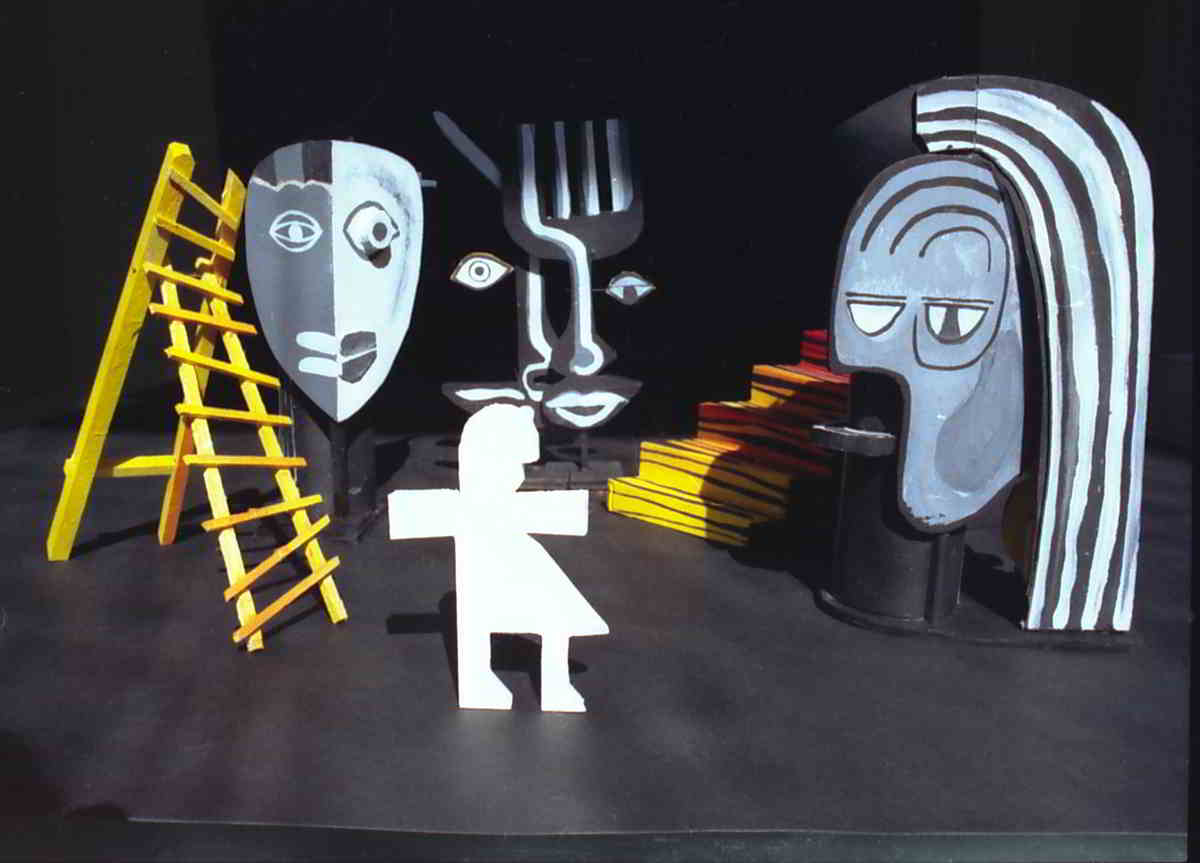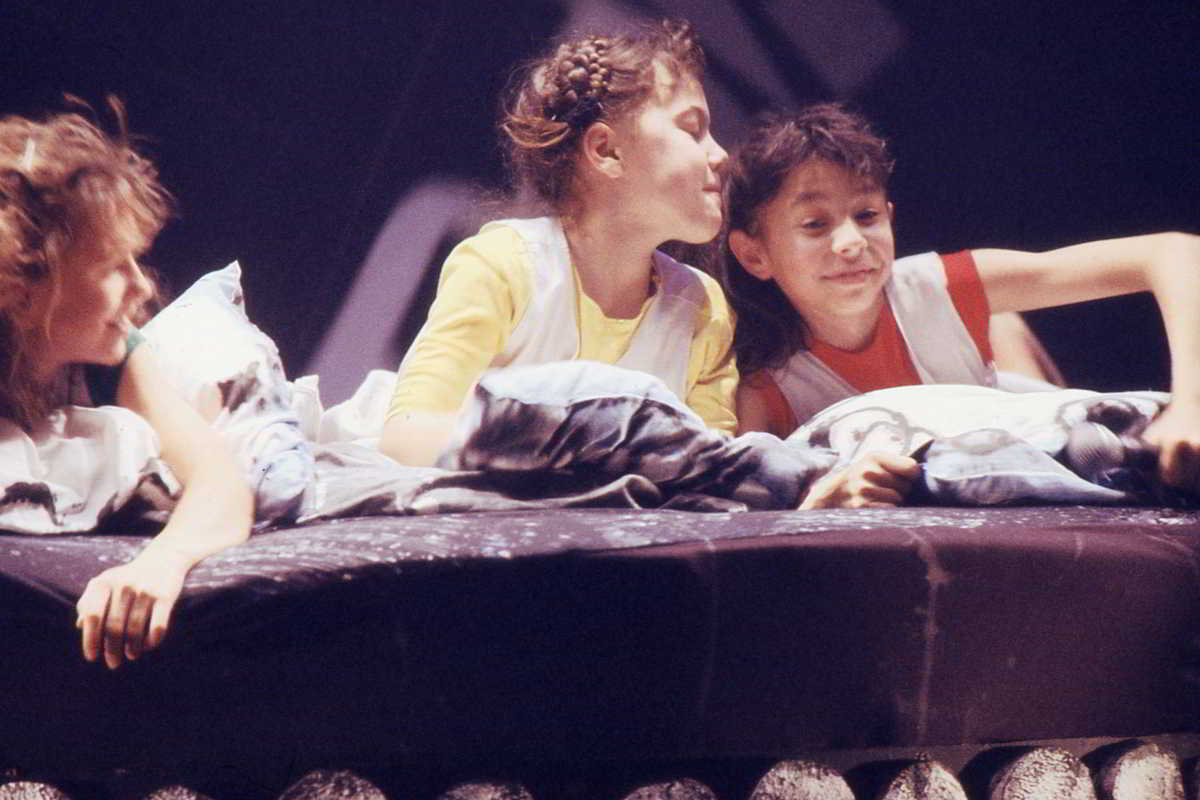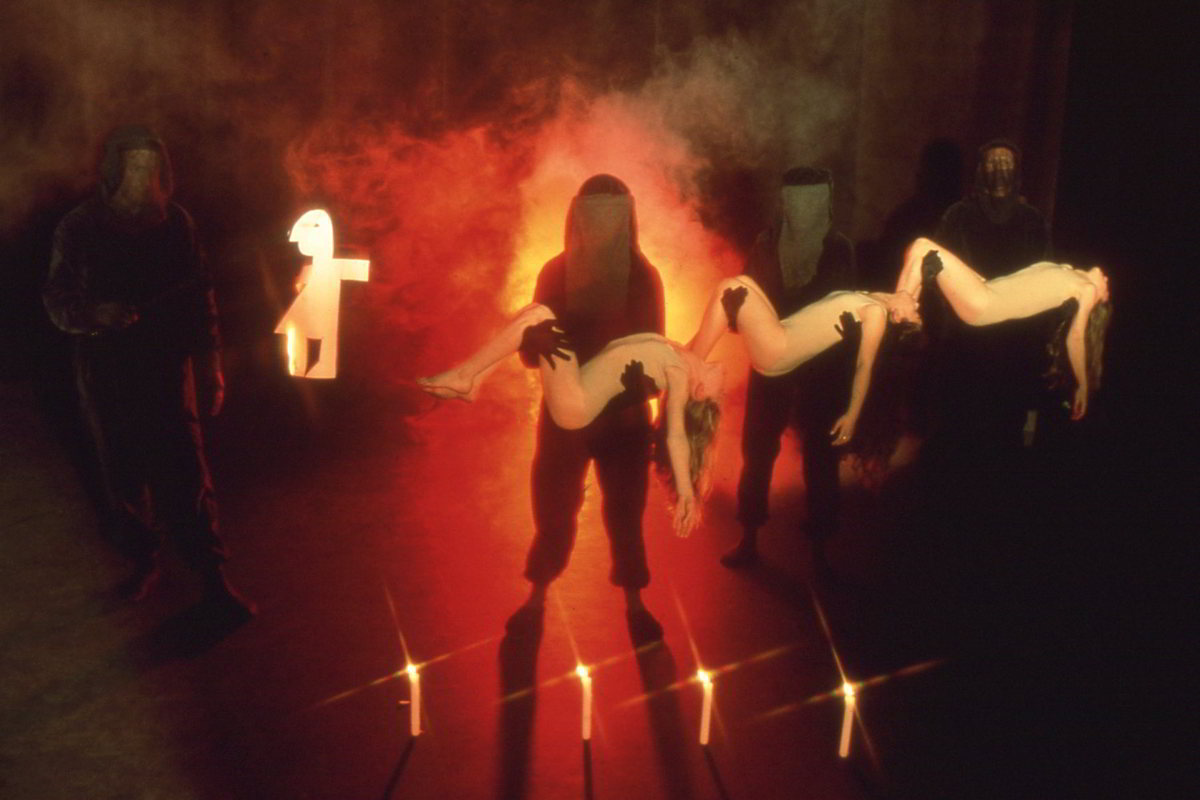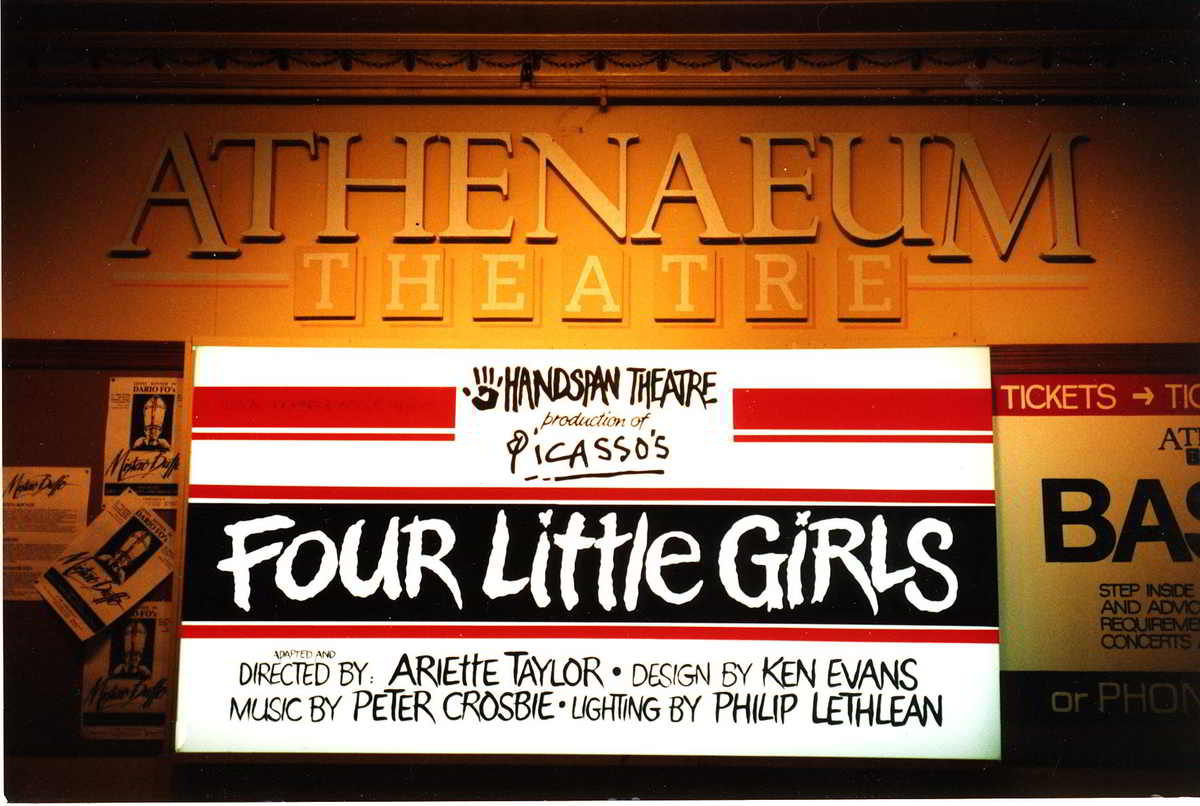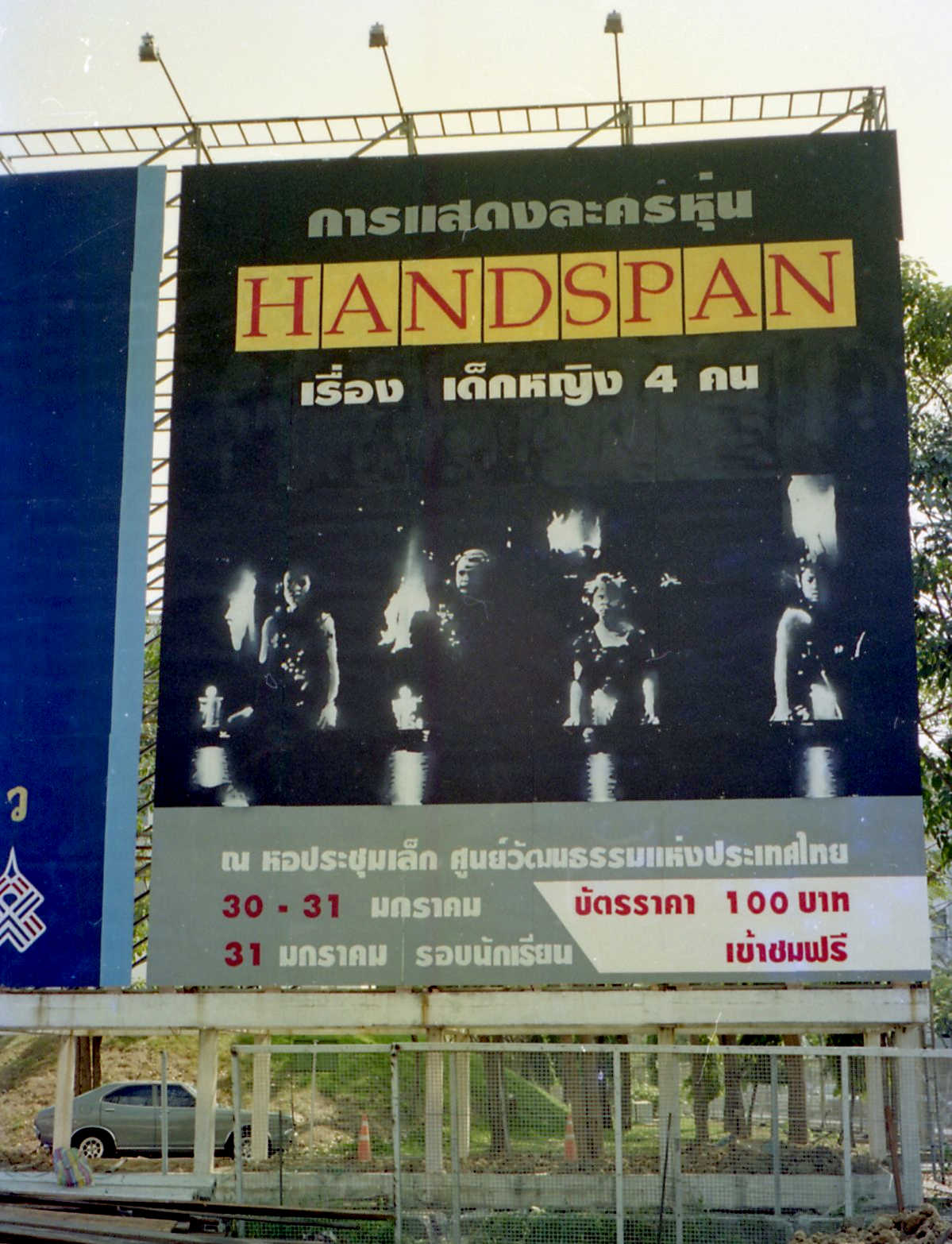| Premiere | 18 March 1988 |
| Venue | Arts Theatre, Adelaide Festival of Arts, Adelaide SA |
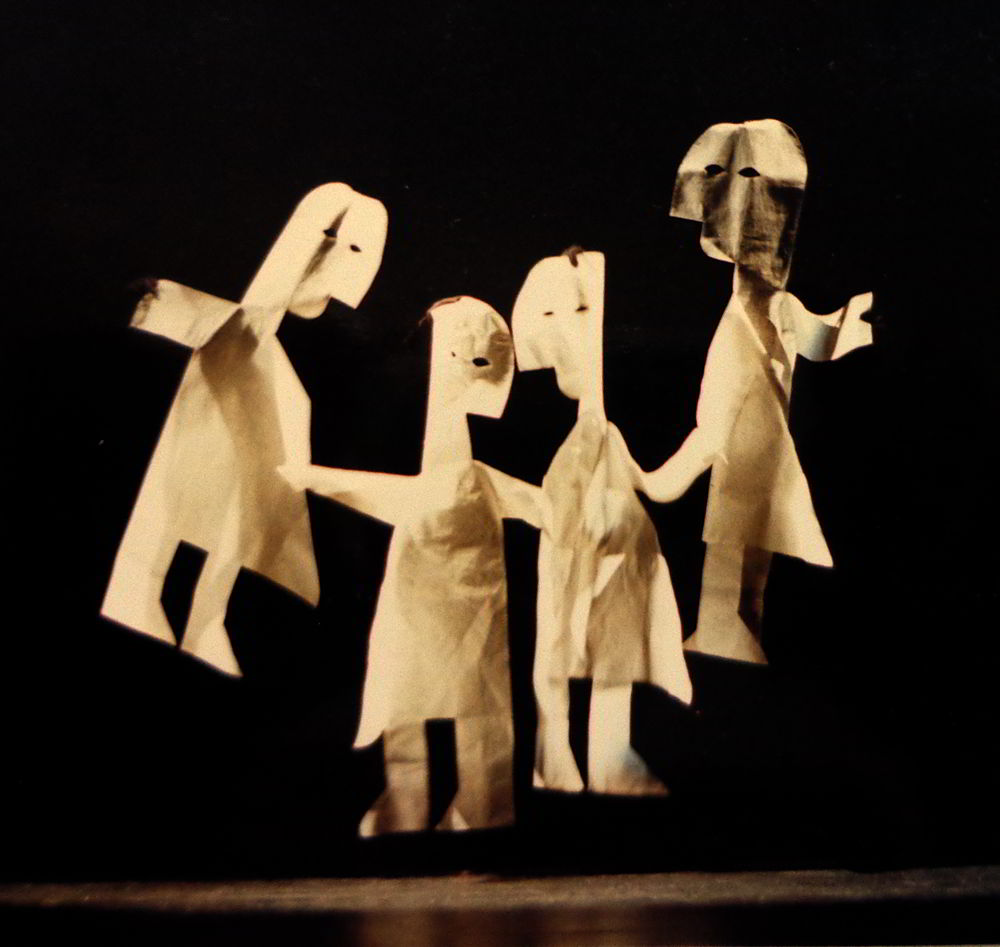
FOUR LITTLE GIRLS was a major work for Handspan Theatre and earned the company critical accolades throughout Australia, in South America and in South-East Asia.
The production stayed in the company’s repertoire for over a decade: it premiered at the 1988 Adelaide Festival of Arts; and won the UNESCO Prize for the Promotion of the Arts in 1994 in Bogota, Columbia, singled out for:
Technical perfection and high poetic and imaginative quality.
It featured in the King of Thailand’s Jubilee celebrations in Bangkok in 1996; and played its final performances at the 11th Festival International de Teatro in Caracas, Venezuela in June 1997.
The Play
The text, Playscript 32 was one of two plays written by Pablo Picasso in 1948. Set in a French provincial garden with an atmosphere of magic timelessness the script has no narrative plot. It is instead a series of images and observations that explore the secret games, rituals and dreams of young children, as well as their fears about life, love, sexuality and death.
Handspan’s production, devised and directed by Ariette Taylor, was based on her own adaptation of Picasso’s published work developed through a series of workshops begun in 1980 in Adelaide, South Australia.
Well-known for her choreographic works with child performers, Ariette worked with girls under 10 exploring the ideas embedded in Picasso’s stream-of-consciousness text towards creating an initial movement-based dramatisation of the work:
I didn’t know if young girls could say the words of Picasso’s text so the workshops were mainly improvisations around being frightened and ideas of life and death.
Years in the making
Workshops evolved over several years and with new children and late 1985, Handspan's Executive Director, Helen Rickards saw its latest showcase, Nine Little Girls in Adelaide and excited by its possibilities for a new contemporary visual theatre production for adult audiences, initiated the partnership between Handspan and Ariette.The unique collaboration, that ensued produced by Helen's successor, Trina Parker, designed by Ken Evans with lighting by Philip Lethlean, for premiere seasons in Australia's Bicentennary Celebrations (1988) proved to be an inspired partnership that lasted a decade.
Ariette had always envisioned the work to be staged in a world rich with Picasso-eque imagery using puppetry to bring the little girls' world alive.
I knew what I wanted to see, a moving set, the paper girls, the animals, the coffins and the devils, but didn't know how to get it!
Before she met Handspan, Ariette Taylor had tried to engage producers in Adelaide and Perth, and in Melbourne, on meeting the company, she found the collaborators she'd been seeking:
10.30 am 17 April, 1986:
I walked up the broad stairs of Handspan's studio in Gertrude St Fitzroy. As I recall, I had never seen a Handspan show and I didn't know anyone from the company. I was dead nervous. It was eerily quiet ... I called out at the door, and waited... 'Come in!'
Ken Evans and Andrew Hansen, both startlingly cool, artist-like and handsome, sat, legs-on-table, looking at me. It was a late summer's day, sun streaming in the windows, the company had just finished packing up The Haunted ...
Stuttering badly, I proposed Four Little Girls ... Ken knew the work - he had seen it performed by adult women at some time - and liked it! ...
For him, it was 'the next great show walking in'. I flew down the stairs ...'At last!'
Animating the artist
FOUR LITTLE GIRLS was the first of Handspan’s productions that animated the images of a visual artist. It was not only a play written by Pablo Picasso, painter and renowned surrealist, but its design and imagery drew heavily on the artist’s work. Later Handspan productions, Viva la Vida - Frida Kahlo (1993) and Daze of Our Lives (1995), similarly drew on visual artists for their source material, the former celebrating Mexican artist Frieda Kahlo and the latter Melbourne cartoonist, Mary Leunig.
Handspan has chosen a painterly, rather than a literary approach to the play, where imagery replaces wordiness, and this works beautifully.The impression one gains is of fantastical dreamscapes, of moving Picasso canvasses, of imaginations, of fears. The production targets one’s senses.
Ken Evans’ images were based on Ariette's adaptation of the original text and stage directions of the play but owed more to Picasso and his contemporaries' paintings than to his written word. The child actors interacted with highly stylised puppets created and manipulated by the company ensemble of black-clad puppeteers largely hidden from view by tightly directed lighting and judicious smoke screens.
I gave the piece its shape, but Handspan's extraordinary skill in black theatre and their creative problem solving was the greatest revelation to me.
The puppet and object images worked on several levels. At times, they abstracted the four little girls themselves, representing them as cut out paper dolls and body outlines that could interact with the girl actors and move around and amongst the set pieces and scenes. They also represented Picasso’s imagined ideas of the children – brides, horses, birds and goats, boats, the sun and flowers; and the more sinister - satyrs, ghosts, coffins and demons. The puppeteers themselves occasionally appeared on stage, manipulators of the girls’ fantasy, sometimes benign, sometimes threatening. The images of the piece alluded to the work of Chagall and Cocteau as much as Picasso, at times they were compared to Boyd1
and Klee2
Four Little Girls is rivetingly beautiful and refreshingly different, being more an experience of visual art than of conventional proscenium theatre.
‘Puppet’ is an inadequate description of the inanimate objects designed by Ken Evans. They are shapes and figures derived from Picasso images – abstract, cubist, suffering, compassionate, frightening.
Handspan's production of FOUR LITTLE GIRLS was the first (and possibly remains the only) performed by small girls as Picasso must have intended4. His little girls are anonymous; symbols of the child. He calls them First Little Girl, Second Little Girl, Third Little Girl and Fourth Little Girl. Ariette’s adaptation coalesced the play into four acts: ‘About Life’, ‘About Death’, ‘About Growing Up’ and ‘About Childhood Gone’. The girls spoke Picasso’s words including his stage directions, in fragmented and often apparently disconnected scenes. They ran, hid, jumped, and played in a world of fantastic and often frightening images. Dialogue was punctuated by the girls’ childish giggles and though its poetry was rarely in a child’s language, it was delivered with the playful enjoyment of the young for whom the words, images and situations are all a game.
It is not so much a story, but an extended moment. It is the moment when the four girls approach and stand on the edge of growing up.
The music is the foundation of the drama and the recurring opening theme stresses the darkness of childhood and growing up.
The play's action was driven by Peter Crosbie's powerful, throbbing soundscape, and in adapting the original text, Ariette took phrases from the script, including its stage directions, and incorporated them into poetic dialogue that was spoken by the girls. Their refrain expressed the play’s intent: 'I don’t want to grow up ...But you have to ...' Crosbie worked outside the rehearsal room with Ariette to write the score for the play from her concepts and instructions. Ariette recalled that when he finally saw the work in rehearsal, he was horrified and begged her to abandon the project to protect his, and her, reputations! But, Ariette and Handspan remained confident, and by opening night, Crosbie was as proud of the work as everyone else.
Loud insistent music, beating to the edge of pain, makes one long for the horror to stop. And the fact that it stops on the very lip of anger, makes the drama more exciting and proves the excellent timing and theatrical ability.
FOUR LITTLE GIRLS was staged by child actors playing the four little girls in the animated world of their dreams and imaginings. This was an essential element for both Ariette and Handspan:
It demanded child actors – the loaded sexuality of adults would immediately dis-empower the production. I had to free myself and them from the guilt involved in talking about life and death.
Contrary to Picasso's text, however, the girls were not nude, an adaptation that did not go un-remarked by critics:
Handspan’s FOUR LITTLE GIRLS was heavy with the scent of innocence in its players. It was frightening and delightful, but ultimately sad that the innocence exuded by the title players could not be presented as Picasso had seen it, for fear it would not be reflected by the audience. That’s a criticism not of Handspan which had no choice but to clothe the children, but of our society which preys on innocence rather than simply observing it.
A long life
Trina Parker produced FOUR LITTLE GIRLS throughout its development and first seasons and tours of the play. She secured new financial support and significant mainstream touring opportunities for the production which through its artistic success brought Handspan an extended national and international reputation .
At the same time, Trina created a production structure that both developed the company ensemble and nurtured its young guest artists. Eight little girls were cast, a nanny/teacher was hired and the rehearsal and touring commitments carefully scheduled. Production management for FOUR LITTLE GIRLS moved Handspan across a new threshold of professional practice that secured its future beyond its earlier capacity as an artist collective.
The production premiered and toured Australia in 1988 as part of Australia's Bicentenary Cultural Program earning critical accolades from the outset:
Whatever criticism may be leveled at events surrounding the Bicentenary, Canberra can be grateful for at least one momentous occasion when the Authority made it possible for Four Little Girls to be performed here.
Handspan’s catalogue of works is rich in experimentation and stylistic daring. With the tumultuous and exquisite contradictions on offer in Four Little Girls, they have enhanced their reputation still further.
In 1994 when the work was remounted to tour internationally for the first time, Leonard Radic again found it:
An enchanting piece remarkable for its images and its sheer theatricality ...rich in incident and imagination and powerful in its ability to conjure up the light and dark world of childhood.
The play's final tour in South America, still performed by the original Handspan ensemble again with new 'little girls' was a challenge for the company. Gunfire and cocaine fights on the streets surrounding their hotel was confronting; the serious illness of a company member; and and the looming death of a company compatriot brought sadness; and the sudden on-the-road re-casting required by these circumstances brought anxiety and nervous tension to the production's last season.
However the production remained outstanding:
It is as pertinent, as magical, as challenging now as it was in 1988, and will remain so.
Footnotes:
Links:
Four Little Girls - Picasso's Perspective On Life Australian Elizabethan Theatre Trust News, April 1988
| Creative team | |
|---|---|
| Writer | Pablo Picasso (1948) Playscript 32 |
| Adaptation | Ariette Taylor |
| Director | Ariette Taylor |
| Producer | Trina Parker |
| Director's assistant | Jim Cathcart |
| Designer | Ken Evans |
| Lighting designer/operator | Philip Lethlean |
| Composer | Peter Crosbie |
| Sound operator/Tour manager | Paul Judd |
| Costume designer | Trish Simmons |
| Creative development 1986 | |
|---|---|
| Adelaide girls | Nuala Hafner, Sarah Atkinson, Emma Matishe, Annabelle Warwick |
| Handspan artists | Lizz Talbot, David Hope, Andrew Hansen, Peter J.Wilson, Avril McQueen |
| Performers | |
|---|---|
| First Little Girl, The Smallest | Sacha Markin/Phoebe Belcher (1988), Tara Roulston (1994-7) Sally Garrett (1996-7) |
| Second Little Girl, The Story Teller, Clairvoyant | Mary-Anne McCormack/Danita Hansen(1988) Jeuliette Hanafie, Bree-Anna Obst (1994) Jane Harber (1996-7) |
| Third Little Girl, The Odd One Out, Secretive | Christina Tan/Kelly Sulikowski (1988), Chloe Armstrong (1994-7) |
| Fourth Little Girl, The Eldest, Pre Pubescent | Alexandra Sangster/Emily Wagon(1988), Katie Miscevic/Dana Gishen (1994), Chloe Armstrong (1997) |
| Puppeteers | Andrew Hansen, Jonathan Taylor (stand-in 1997) |
| Avril McQueen | |
| David Hope, Rod Primrose, (Rob Matson) | |
| Lizz Talbot | |
| Peter J.Wilson (Winston Appleyard) |
| Production team | |
|---|---|
| Puppet realisation | Michele Spooner |
| Construction & painting | Philip Lethlean, Cliff Dolliver, Paul Newcombe |
| Production assistants | Kerry McIlroy, Sue Davis, Susan Williams, David Hope |
| Stage managers | Ruth Hardman, Mikkel Mynster |
| Assistant stage manager | Jim Cathcart (1986), Sandy Cook (1988) |
| Creative development co-ordinator | Carmelina Di Guglielmo |
| Vocal coach & Tutor | Annie Wylie |
| Nanny | Anita Triado |
| Graphics | John Dickson |
| Showcase previews | |
|---|---|
| 18 & 19 July 1986 | Handspan Theatre Studio, Fitzroy VIC |
| Seasons | |
|---|---|
| March 1988 | Arts Theatre, Adelaide Festival, Adelaide SA |
| The Playhouse, Oz Puppet Festival, Perth, WA | |
| April 1988 | The Canberra Theatre Centre, Canberra ACT |
| May 1988 | The York Theatre, Seymour Centre, Sydney NSW |
| June 1988 | The Randall Theatre, St Martins Youth Arts Centre, Melbourne VIC |
| 19 June - August 1988 | Athenaeum Theatre, Melbourne VIC |
| March 1994 | Teatro National, Festival Ibero Americano de Teatro, Bogota, Columbia |
| 29 June 1994 | Gedung Kesenian, Australia Today, Indonesia ’94, Jakarta, Indonesia |
| 27 July – 6 August 1994 | George Fairfax Studio, Victorian Arts Centre, Melbourne, VIC |
| January 1996 | International Festival of Performing Arts in the Fiftieth Anniversary Celebrations of His Majesty’s Accession to the Throne, Small Hall, Thailand Cultural Centre, Bangkok, Thailand |
| January 1996 | Federation of Asian Cultural Promotion (Excerpts), Victorian College of Arts Drama Studio, Melbourne, VIC |
| June 1997 | Teatro National, 11th Festival International de Teatro, Caracas, Venezuela |
| Total performances | |
|---|---|
| 90 (1988 only) |
| Total audience | |
|---|---|
| 18,640 (1988 only) |
FOUR LITTLE GIRLS was photographed by several photographers from its creative development and rehearsal at in Handspan's Fitzroy studio and the nearby Fitzroy Town Hall through formal and informal photo sessions on its touring stages.
Photographs:
The Gallery images are a selection from the FOUR LITTLE GIRLS photographs held in the Handspan Theatre Collection at the Arts Centre Melbourne, Performing Arts Collection. Any photographs held in private collections are identified.
FOUR LITTLE GIRLS Photographers in the Performing Arts Collection include:
David Simmonds
Ken Evans
Shaw Tan
Miki-nobu Komatsu
as well as unknown picture takers or company snapshots.
Individual Gallery photographs include photographer credits with photo captions unless attribution is unknown.
Video footage
Video clips have been compiled from Handspan Theatre's old VHS archive and include extracts of performance footage and promotional newsreels including all credits available.
Click link to view: GALLERY
